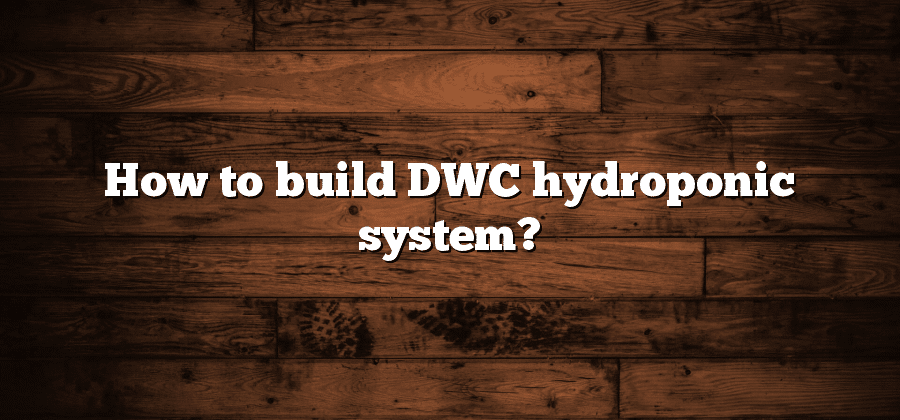Understanding Deep Water Culture Hydroponics
Hydroponics, a method of growing plants without soil, has gained significant popularity in recent years. One of the most effective and widely used techniques within hydroponics is deep water culture, or DWC. This method involves suspending plant roots in a nutrient-rich solution, allowing for continuous access to the necessary elements for growth. Understanding the principles behind deep water culture hydroponics is essential for successful cultivation.
In DWC hydroponics, plants are placed in buckets or containers filled with the nutrient solution, with the roots hanging directly into the liquid. This technique ensures that plants receive ample oxygen, as a constant stream of air bubbles is introduced into the solution. The oxygen-rich environment promotes rapid root development, leading to accelerated growth and increased nutrient uptake. Additionally, the deep water culture method allows for better control of pH and nutrient levels, enabling precise adjustments to meet the specific needs of each plant species. By embracing deep water culture hydroponics, horticulturists can enjoy higher yields and faster growth rates compared to traditional soil-based cultivation methods.
Selecting the Right Materials for Your DWC System
When it comes to setting up a Deep Water Culture (DWC) hydroponics system, selecting the right materials is crucial for success. One of the most important components of a DWC system is the reservoir. It is recommended to choose a food-grade container that is sturdy and has a lid to prevent light from entering and algae growth. The size of the reservoir will depend on the number of plants you plan to grow, but it should be large enough to allow ample space for the roots to grow and the nutrient solution to circulate.
Another essential material for a DWC system is the air pump and air stones. These are responsible for providing oxygen to the roots and preventing them from suffocating. It is important to invest in a high-quality air pump that can deliver enough air to adequately oxygenate the nutrient solution. The air stones, on the other hand, should be made of a durable material such as ceramic or stainless steel to ensure long-lasting performance.
Additionally, selecting the right net pots and planting medium is crucial for the proper growth and support of your plants. Net pots are often made of plastic or mesh material and should be the appropriate size to accommodate the root structure of your chosen plants. The planting medium, such as clay pebbles or Rockwool cubes, should provide good aeration and drainage to prevent waterlogging of the roots. By carefully selecting these materials, you can create an optimal environment for your plants to thrive in a DWC hydroponics system.
Preparing Your Reservoir for DWC Hydroponics
To successfully prepare your reservoir for DWC hydroponics, there are several important steps to follow. First, it is crucial to clean your reservoir thoroughly before use. Any lingering dirt or contaminants can hinder the growth of your plants and affect the overall health of your system. Use a mild detergent and warm water to scrub the reservoir, ensuring that all surfaces are free from debris. Rinse it thoroughly to remove any soap residue.
After cleaning, it is essential to ensure that your reservoir is properly sanitized. This step is critical in preventing the growth of harmful bacteria and pathogens that can harm your plants. There are various sanitizing agents available in the market specifically designed for hydroponic systems. Follow the instructions provided by the manufacturer to achieve the desired level of cleanliness. Remember, maintaining a sterile environment is crucial for the success of your DWC hydroponics system.
Setting Up the Air Pump and Air Stones
To ensure the proper oxygenation and circulation of your DWC hydroponic system, setting up the air pump and air stones is crucial. The air pump is responsible for delivering a continuous supply of oxygen to the roots of your plants underwater. When selecting an air pump, opt for one that is appropriate for the size of your system and capable of delivering the necessary air flow. It is advisable to choose a pump with adjustable air pressure, as this enables you to regulate the oxygen levels according to the specific needs of your plants.
Once you have chosen the appropriate air pump, it is time to install the air stones. These porous stones, typically made of ceramic, allow for the dispersion of small bubbles throughout the nutrient solution. This process enhances the oxygenation process by increasing the surface area for gas exchange. When installing the air stones, ensure that they are evenly distributed across the bottom of the reservoir. This will ensure uniform oxygenation and prevent any dead spots where oxygen may not reach. Additionally, regularly inspect the air stones for any blockages or buildup of mineral deposits, as these can impede the flow of air and compromise the oxygen levels in your system.
Installing the Net Pots and Planting Medium
Now that your DWC system is properly set up and your reservoir is ready, it is time to move on to the next step: installing the net pots and planting medium. The net pots are small containers that hold the plants in place while allowing their roots to dangle freely in the nutrient-rich water below. These pots are usually made of plastic or mesh material, which provides stability and support to the plants.
Before inserting the net pots into the system, it is important to choose the right planting medium. There are various options available, such as clay pebbles, coco coir, and rockwool. Each medium has its own advantages, so consider the specific needs of your plants and the conditions of your environment when making your selection. Once you have chosen the planting medium, fill each net pot with a sufficient amount, ensuring that it is secure and evenly distributed. This will provide stability for the plants as their roots grow and take hold.






